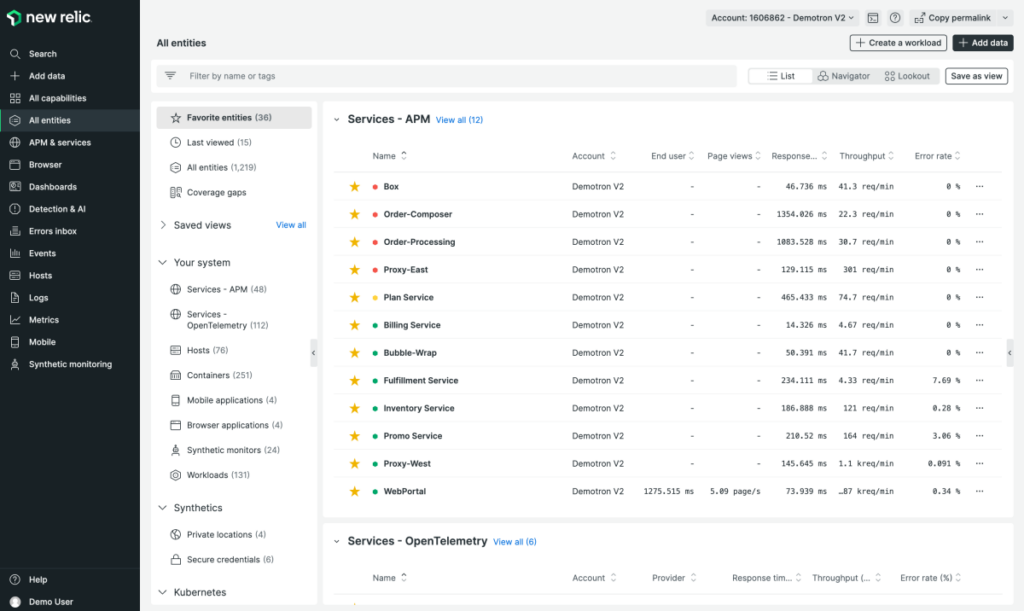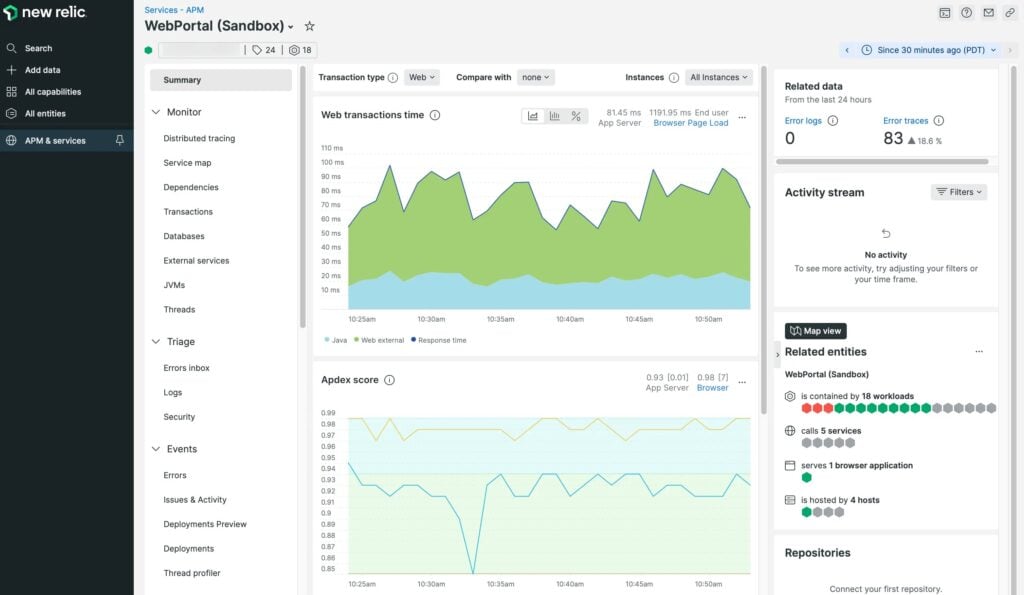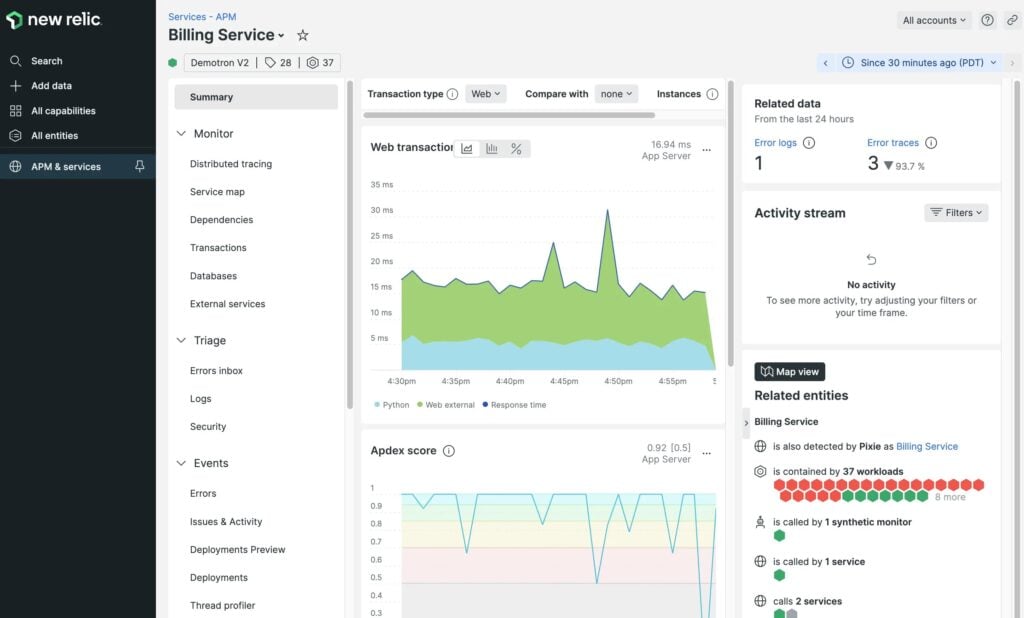With decades of experience in observability tech, I've seen tools of all kinds—some great, some not so much. In this review, you'll get all the information you need to decide if New Relic is the right software for your use case.

New Relic Software Product Overview
New Relic offers end-to-end observability and monitoring tools for software systems. Target users range from DevOps to Site Reliability Engineers. The tool allows you to detect system bottlenecks before they become critical issues. Its standout features include robust APM, AI-driven anomaly detection, and comprehensive dashboards.
Moreover, New Relic facilitates the gathering of information from diverse sources and aids in resolving both front-end and back-end problems as well as CPU surges. New Relic collects not only system metrics but also performance indicators and customer experience data across a variety of applications.
Pros
- Robust APM: Application Performance Monitoring solution is where New Relic shines, providing deep insights into your applications' behavior.
- AI-Driven Anomaly Detection: The tool intelligently flags unusual system behavior, offering valuable foresight into potential issues.
- Comprehensive Dashboards: The dashboards present your metrics, logs, and traces in an easily digestible format, making system health instantly apparent.
Cons
- Learning Curve: The tool can be complex for newcomers, requiring a significant time investment to master.
- Resource Intensive: On smaller deployments, the tool can be somewhat of a resource hog.
- Limited Integrations: While it offers several integrations, New Relic lags behind some competitors in this area, constraining your choice of third-party tools.
Expert Opinion
Judging by features, functionality, support, interface, integrations, and onboarding ease, New Relic stands out in many respects. It excels in Application Performance Monitoring as an APM solution and its AI-driven anomaly detection is a valuable asset.
However, it is resource-intensive and could be a bit overwhelming for newcomers. In terms of functionality and integrations, it does lag behind some of its competitors. For large-scale deployments and teams with a bit of experience, New Relic proves to be a solid enterprise monitoring tool.
Also, New Relic is solid when it comes to debugging, it works with various frameworks and tools such as Slack and Microsoft Azure.
New Relic: The Bottom Line
In fact, what sets New Relic APM apart from other observability platforms is its proficiency in full stack Application Performance Monitoring. It also offers unique AI-driven anomaly detection that adds an extra layer of security by flagging potential issues before they escalate.
Its dashboards are notably comprehensive, providing an instant snapshot of system health that is invaluable for quick decision-making.

New Relic Deep Dive
Product Specifications
- Application Performance Monitoring (APM) - Yes
- Log Management - Yes
- Distributed Tracing - Yes
- Metrics Collection - Yes
- Anomaly Detection - Yes
- Alerting and Notifications - Yes
- Dashboard Visualization - Yes
- Infrastructure Monitoring - Yes
- API Monitoring - Yes
- Code Profiling - Yes
- Security Monitoring - Yes
- Incident Management - Yes
- Data Retention - Yes
- Mobile App Monitoring - Yes
- Browser Monitoring - Yes
- Custom Metrics - Yes
- Real User Monitoring (RUM) - Yes
- Service Maps - Yes
- Configuration Management - Yes
- Synthetic Monitoring - Yes
- SLA Reporting - Yes
- Compliance Management - Yes
- Network Monitoring - No
- Kubernetes Monitoring - Yes
- Multi-Cloud Monitoring - Yes
New Relic Feature Overview
- Application Performance Monitoring (APM): New Relic offers in-depth APM, capturing data points like response times, error rates, and user satisfaction.
- Log Management: The platform provides an intuitive way to centralize and analyze logs, which helps in troubleshooting and root cause analysis.
- Distributed Tracing: This feature enables you to view a distributed system as one application, making it easier to understand how services interact.
- Metrics Collection: New Relic collects a wide array of system and application metrics, offering a more rounded understanding of your environment.
- Anomaly Detection: Driven by AI, this feature flags unusual behavior, enabling quick intervention to prevent larger issues.
- Alerting and Notifications: New Relic's alerting system is highly customizable, allowing precise configurations to meet your needs.
- Dashboard Visualization: Dashboards are comprehensive yet easy to interpret, providing a quick snapshot of system health.
- Infrastructure Monitoring: This extends your observability to underlying infrastructure like servers and databases, adding another layer to your insights.
- API Monitoring: This is particularly useful for businesses that depend on several internal and external APIs for their operation.
- Code Profiling: Allows you to see how your code behaves in production, making it easier to spot inefficient code paths.
Standout Functionality
- AI-Driven Anomaly Detection: Most platforms offer anomaly detection, but New Relic’s is AI-driven, making it more accurate and efficient.
- Service Maps: New Relic provides service maps that offer a visual representation of your application’s architecture, a rarity in most other tools.
- Real User Monitoring (RUM): The RUM functionality offers insights into real user interactions, adding a human element to your observability efforts.
Integrations
New Relic offers native integrations with AWS, Azure, and Google Cloud. It also has plugins for popular databases like MySQL and PostgreSQL. Its API allows you to extend its capabilities through custom integrations.
New Relic Pricing
New Relic offers several pricing tiers, starting from a free tier. A standard tier could cost around $99/user/month (min 5 seats), offering APM, log management, and basic alerting. The pro tier at $249/user/month adds more advanced features like AI-driven anomaly detection and service maps. Most plans are billed annually.
Ease of Use
The user interface of New Relic is intuitive but can be complex given the plethora of features it offers. The onboarding process could be smoother, especially for people new to observability tools.
Customer Support
New Relic provides a range of customer support channels, including live chat, documentation, and webinars. However, the response times could be faster, a common concern among users.

New Relic Use Case
Who would be a good fit for New Relic?
In fact, New Relic finds its most avid and loyal customers among large enterprises with complex, multi-layered software systems. Moreover, DevOps teams, Site Reliability Engineers, and even CTOs in industries like eCommerce, FinTech, and SaaS value the depth of observability New Relic provides.
It's a particularly strong fit for businesses that require real-time insights into application performance and anomalies. Teams that are mature in their observability practices will find New Relic to be incredibly beneficial.
Who would be a bad fit for New Relic?
Smaller startups or teams with less experience in observability may find New Relic overwhelming. If you're running a lean operation with minimal infrastructure, the tool can feel like an overkill and even be resource-intensive.
Companies that need quick, straightforward solutions might find the feature-rich environment and the initial learning curve to be a turnoff. Businesses looking for a simplified, low-cost solution might not find New Relic to be the best fit.
New Relic Review FAQs
Does New Relic offer a free trial?
Yes, New Relic offers a free tier with limited features.
Is there a mobile app for New Relic?
Yes, New Relic offers a mobile app for both Android and iOS, allowing you to monitor your systems on the go as an application performance management because it offers performance metrics.
Can I customize the dashboard?
Yes, the dashboard is highly customizable, enabling you to focus on metrics that are most important to you.
Does New Relic offer Anomaly Detection?
Yes, New Relic has AI-driven anomaly detection to flag unusual system behavior.
How does New Relic integrate with other cloud services?
New Relic offers native integrations with popular cloud providers like AWS, Azure, and Google Cloud.
Can New Relic monitor multiple cloud environments?
Yes, it provides multi-cloud monitoring capabilities, making it possible to track resources across different cloud providers.
Is there support for Kubernetes monitoring?
Yes, Kubernetes monitoring is a feature that New Relic offers.
How extensive is customer support?
Customer support is available through various channels including live chat, documentation, and webinars, although response times could be faster.
Alternatives to New Relic
While New Relic is a solid monitoring tool choice, there are several New Relic alternatives available:
- Datadog: Known for its robust log management capabilities, Datadog might be the better choice for you if centralized logging is a critical need.
- Prometheus: If you're more inclined toward open-source solutions and have a smaller budget, Prometheus excels in cost-effectiveness while still offering comprehensive metrics capabilities.
- Splunk: Splunk shines in data analytics and SIEM (Security Information and Event Management), making it ideal for those who need stronger security analytics features alongside observability.
If you're still unsure which alternative to choose, read more about other best monitoring tools.
New Relic Company Overview & History
New Relic is a San Francisco-based software analytics company founded in 2008 by Lew Cirne. The company specializes in real-time observability and has garnered a broad clientele, including major players in ecommerce, FinTech, and SaaS industries. As a publicly-traded company under the ticker symbol NEWR, they operate globally.
Notable board members include Hope Cochran and James Tolonen. The company's mission statement is "Instrument, measure, and improve the internet to help our customers create more perfect software, experiences, and businesses."
As a matter of fact, over the years, New Relic has reached several milestones, including its IPO in 2014 and the acquisition of SignifAI, an event intelligence company, in 2019.
Summary
So, having navigated the ins and outs of New Relic Review, it's clear that the tool excels in providing deep observability features suitable for larger enterprises and teams mature in their observability practices.
While it may not be the right fit for everyone, those who align with its strengths will find it incredibly valuable. Feel free to comment and share user experiences; your input is highly welcomed.
